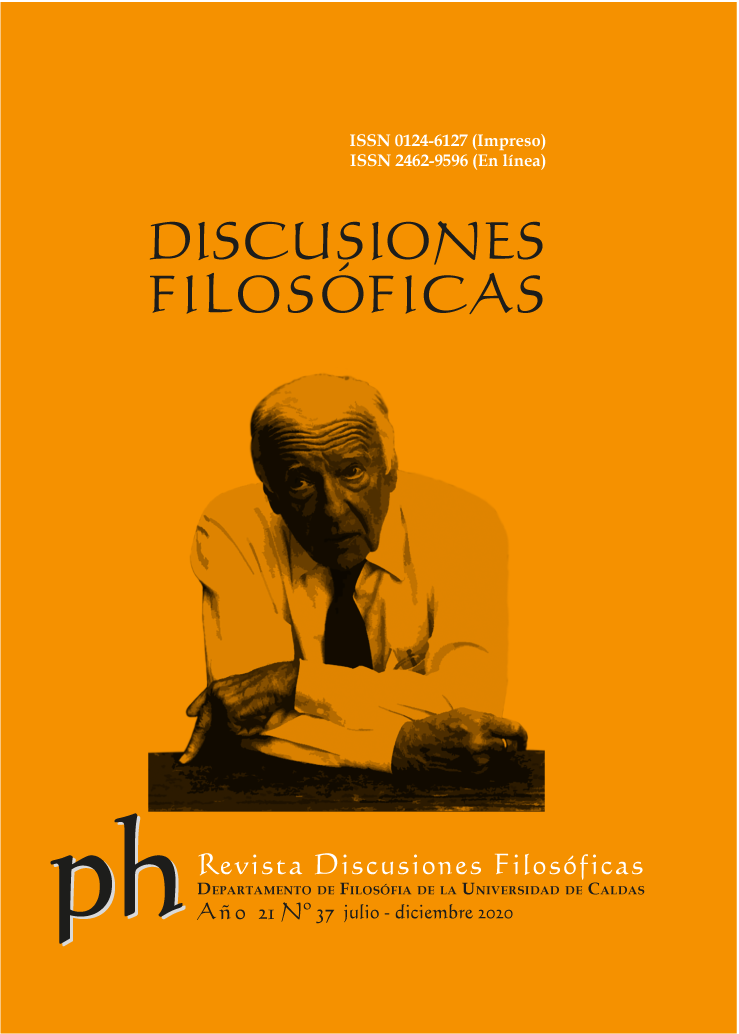Authors
Abstract
This paper addresses the question of whether awareness of the spatial properties of our body is achieved through bodily sensations. We begin by analyzing our current understanding of the spatial dimension of bodily sensations. The notion of non-observational knowledge is introduced as the main objection to the idea that bodily sensations are the means by which we are aware of any spatial property of our body. We discuss two important philosophical criticisms of such a notion, as well as a series of empirical findings that could be interpreted as objections. We finish by considering an alternative explanation of our awareness of the spatial properties of our body.
References
Anscombe, Gertrude Elizabeth Margaret. Intention. Harvard University Press, 1957.
____. “On sensations of position.” Analysis 22.3 (1962): 55-58. https://www.jstor.org/stable/3326426
Armstrong, David Malet. Bodily sensations. Routledge, 1962.
Bays, Paul M., and Daniel M. Wolpert. “Computational principles of sensorimotor control that minimize uncertainty and variability.” The Journal of physiology 578.2 (2007): 387-396. https://doi.org/10.1113/jphysiol.2006.120121
Bermúdez, José Luis. The paradox of self-consciousness. MIT Press, 1998.
Botvinick, Matthew, and Jonathan Cohen. “Rubber hands ‘feel’ touch that eyes see.” Nature 391.6669 (1998): 756. https://doi.org/10.1038/35784
Burgess, P. R., et al. “Signaling of kinesthetic information by peripheral sensory receptors.” Annual review of neuroscience 5.1 (1982): 171-188.
Carson, Richard G., Stephan Riek, and Nosratollah Shahbazpour. “Central and peripheral mediation of human force sensation following eccentric or concentric contractions.” The Journal of physiology 539.3 (2002): 913-925. https://doi.org/10.1113/jphysiol.2001.013385
Cullen, Kathleen E. “Sensory signals during active versus passive movement.” Current opinion in neurobiology 14.6 (2004): 698-706. https://doi.org/10.1016/j.conb.2004.10.002
De Vignemont, Frédérique. Mind the body: An exploration of bodily self-awareness. Oxford University Press, 2018.
—. “Body schema and body image—Pros and cons.” Neuropsychologia 48.3 (2010): 669-680. https://jeannicod.ccsd.cnrs.fr/ijn_00512315
—. «Bodily spatial content.» Psyche 15.1 (2009).
Devitt, Michael. “Methodology and the nature of knowing how.” The Journal of Philosophy 108.4 (2011): 205-218. https://www.jstor.org/stable/23039015
Goodwin, G. M., D. I. McCloskey, and P. B. Matthews. “The contribution of muscle afferents to kinesthesia shown by vibration induced illusions of movement and by the effects of paralysing joint afferents.” Brain 95.4 (1972): 705-748. https://doi.org/10.1093/brain/95.4.705
Gregory, J. E., D. L. Morgan, and U. Proske. “Aftereffects in the responses of cat muscle spindles and errors of limb position sense in man.” Journal of neurophysiology 59.4 (1988): 1220-1230. https://doi.org/10.1152/jn.1988.59.4.1220
Grigg, Peter, Gerald A. Finerman, and Lee H. Riley. “Joint-position sense after total hip replacement.” The Journal of Bone and Joint Surgery 55.5 (1973): 1016-1025.
Hurley, Susan L. Consciousness in action. Harvard University Press, 1998.
Jones, Lynette A. “Motor illusions: What do they reveal about proprioception?” Psychological bulletin 103.1 (1988): 72. https://doi.org/10.1037/%2F0033-2909.103.1.72
Jones, L. A., and I. W. Hunter. “Effect of fatigue on force sensation.” Experimental neurology 81.3 (1983): 640-650. https://doi.org/10.1016/0014-4886(83)90332-1
Jones, O. R. “Things Known without Observation.” Proceedings of the Aristotelian Society 61 (1960): 129-150. https://www.jstor.org/stable/4544644
Jones, Stephanie A., Erin K. Cressman, and Denise Y. Henriques. “Proprioceptive localization of the left and right hands.” Experimental brain research 204.3 (2010): 373-383. https://doi.org/10.1007/s00221-009-2079-8
Longo, Matthew R., and Patrick Haggard. “An implicit body representation underlying human position sense.” Proceedings of the National Academy of Sciences 107.26 (2010): 11727-11732. https://doi.org/10.1073/pnas.1003483107
Lotze, Rudolf Hermann. Microcosmus: An essay concerning man and his relation to the world [Mikrokosmus: Ideen zur Naturgeschichte und Geschichte der Menschheit, Versuch einer Anthropologie]. Trans. E. Hamilton and E. Jones. Vol. 1. Edinburgh: T & T Clark, 1856.
Macefield, G., S. C. Gandevia, and D. Burke. “Perceptual responses to microstimulation of single afferents innervating joints, muscles and skin of the human hand.” The Journal of Physiology 429.1 (1990): 113-129. https://dx.doi.org/10.1113%2Fjphysiol.1990.sp018247
Mandrigin, Alisa. “The where of bodily awareness.” Synthese, first online: 8 April 2019 (2019): 1-17. https://doi.org/10.1007/s11229-019-02171-3
Margolis, Joseph. “Awareness of sensations and of the location of sensations.” Analysis 27.1 (1966): 29-32. https://www.jstor.org/stable/3326983
Martin, Michael. “Sense modalities and spatial properties.” Spatial Representation. Ed. Naomi Eilan, Rosaleen Mc-Carthy, and Bill Brewer. Oxford: Basil Blackwell, 1993. 206-218.
McDowell, John. “Anscombe on bodily self-knowledge.” Essays on Anscombe’s Intention. Ed. Anton Ford, Jennifer Hornsby, and Frederick Stoutland. Harvard University Press, 2011. 129-146.
McIntyre, A. K. “Central actions of impulses in muscle afferent fibres.” Muscle receptors. Ed. C. Hunt. Berlin, Heidelberg: Springer, 1974. 235-288.
Merleau-Ponty, Maurice. Phénoménologie de la Perception. Paris: Gallimard, 1945. [English translation: Phenomenology of Perception. Trans. Colin Smith. Routledge & Kegan Paul, 1962]
Noë, Alva. Action in perception. Cambridge: MIT Press, 2004.
Noë, Alva, and Kevin O’Regan. “A sensorimotor account of vision and visual consciousness.” Behavioral and Brain Sciences 24.5 (2001): 883-917.
O’Shaughnessy, Brian. “Proprioception and the Body Image.” The Body and the Self. Ed. José Bermúdez, Anthony Marcel, and Naomi Eilan. Cambridge: MIT Press, 1995. 175-203.
—. The Will: A dual aspect theory. Vol. I. Cambridge: Cambridge University Press, 1980. 2 vols.
Pedersen, Jonas, et al. “Localized muscle fatigue decreases the acuity of the movement sense in the human shoulder.” Medicine and Science in Sports and Exercise 31.7 (1999): 1047-1052. https://doi.org/10.1097/00005768-199907000-00019
Penfield, Wilder, and Herbert Jasper. Epilepsy and the functional anatomy of the human brain. Oxford: Little, Brown & Co., 1954.
Pickard, Hanna. “Knowledge of Action without Observation.”Proceedings of the Aristotelian Society 104.1 (2004): 205-230.
Proske, Uwe, and Simon C. Gandevia. “The proprioceptive senses: their roles in signaling body shape, body position and movement, and muscle force.” Physiological reviews 92.4 (2012): 1651-1697. https://doi.org/10.1152/physrev.00048.2011
Russell, Bertrand. The problems of philosophy. Oxford: Oxford University Press, 1912.
Schaefer, Michael, et al. “Fooling your feelings: Artificially induced referred sensations are linked to a modulation of the primary somatosensory cortex.” Neuroimage 29.1 (2006): 67-73. https://doi.org/10.1016/j.neuroimage.2005.07.001
Setiya, Kieran. “Practical knowledge.” Ethics 118.3 (2008): 388-409. Sherrington, Charles S. “The muscular sense”. Textbook of physiology 2 (1906): 1002-1025.
—. The integrative action of the nervous system. Cambridge: Cambridge University Press, 1906.
Velleman, J. David. Practical reflection. Princeton: Princeton University Press, 1989.
Vesey, Godfrey N. A. “The location of bodily sensations.” Mind 70.277 (1961): 25-35.
—. “Knowledge without observation.” The Philosophical Review 72.2 (1963): 198-212.
—. “Bodily sensations.” Australasian Journal of Philosophy 42.2 (1964): 232-247. https://doi.org/10.1080/00048406412341201
Weerakkody, Nivan Sargara, et al. “Force matching at the elbow joint is disturbed by muscle soreness.” Somatosensory and Motor Research 20.1 (2003): 27-32. https://doi.org/10.1080/0899022031000083816

 PDF (Español)
PDF (Español)
 FLIP
FLIP





























